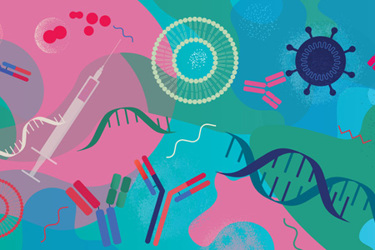RNA Vaccines: Just Scratching The Surface

By Tyler Menichiello, contributing editor

Recently, I had the pleasure of speaking with HDT Bio’s CSO, Dr. Peter Berglund, about the differences between developing therapeutic cancer vaccines compared to those for infectious viral diseases. Berglund is a pioneer of self-amplifying RNA vaccine technology. He has been in the business of self-amplifying RNA vaccine development for over 25 years — previously leading vaccine divisions at Immune Design, Liquidia Technologies, and AlphaVax. This self-amplifying (or self-replicating) RNA, combined with HDT’s localizing ionic nano-carrier (LION), constitutes the company’s AMPLIFY vaccine platform, which Berglund says is well-suited for indications in infectious diseases and oncology.
Editor’s Note: Berglund participated in a Bioprocess Online Live! Event earlier this year, where the discussion focused on overcoming the development and manufacturing challenges facing therapeutic vaccines. You can access a recording of that discussion here.
Infectious Vs. Cancer Vaccine Trials: Common Misperceptions

“Biotechs that lack oncology experience are understandably scared of the risks associated,” he says. “They don’t want to taint the whole platform or technology by reaching toxicity. But when it comes to cancer vaccines — when you induce T-cells to go after and kill a tumor — it’s a numbers game. You have soldiers on each side, and you need to ramp up the immune system and the immune response to levels that are simply much stronger than you need to prevent an incoming viral infection.”
Berglund says one of the biggest differences between developing a vaccine for cancer as opposed to infectious diseases is, perhaps unsurprisingly, the cost. It’s much more expensive to run clinical trials for cancer vaccines. “You take on the costs for the patients’ treatment,” he explains, “which can be hundreds of thousands of dollars per patient.” For infectious disease vaccines, he says, the cost to conduct trials is typically 10 to 20 times lower. Smaller biotechs need to understand these costs and know what to expect when going into cancer vaccine development. “You need to know that you have a path to fund your clinical programs all the way through your important milestones — corporate milestones or inflection points —where you can get more investor capital.”
While trials for both cancer vaccines and infectious disease vaccines have the same desired outcomes — establishing the vaccines’ safety and efficacy — the dynamic of these trials, as well as their clinical endpoints, vary markedly. With cancer vaccines, “you’re going into patients as opposed to healthy volunteers.” This generally means fewer study participants and slower enrollment compared to infectious disease trials.
The bright side of that, Berglund says, is you can evaluate the vaccine’s efficacy much sooner — as early as Phase 1 or 2. This is because you’re able to measure the effects in patients (in terms of tumor growth or reduction) throughout dose escalation. Unlike early-phase infectious disease vaccine trials, where establishing safety is the priority, early-phase cancer vaccines need to demonstrate safety and immunogenicity. “I don’t think any cancer vaccine company would be happy with just demonstrating safety in Phase 1 trials,” Berglund says. “You need to show that it has some sort of potency as well.” For infectious disease vaccines, however, “you don’t really know how good your vaccine is until you’re in Phase 3 and can evaluate whether it protects against an outbreak or not. That might require 30,000 people or more.”
Delivery & Logistics Considerations For RNA Vaccines
Unlike other vaccines that encase RNA in lipid nanoparticles (LNPs), HDT’s positively charged LION carries RNA (which has a negative charge) on its surface. Berglund uses the analogy of a strand of hair clinging to a balloon — the electrostatic binding similarly wraps RNA molecules around the particle. This delivery approach offers several advantages compared to traditional LNPs.
For one, Berglund says, this delivery method makes the RNA more accessible to the cellular machinery once it enters the cell. “Because it’s already on the outside, we spend less time thinking about how to release it into the cytoplasm,” he explains, which is an intense area of research for LNPs. It’s also much safer in terms of biodistribution — where the particles (and RNA) end up in the body. Because cells are negatively charged on their surface (due to proteins and other factors), LION immediately binds to the first cells it encounters — usually muscle cells at the injection site (since immunizations are generally administered intramuscularly). LNPs, on the other hand, generally do not carry a charge, and thus “go everywhere in the body.” According to Berglund, LNPs can accumulate in the liver and may also end up in other sites like the heart and the brain, which can present some safety risks.
Unlike LNPs, which need to be co-formulated with RNA, LION can be manufactured separately and (once refrigerated) remain stable for several years in storage. Being able to “stockpile” LION and reconstitute it on-site has implications for personalized medicine and pandemic readiness alike. Like Berglund says, “having your weapons ready when the war comes is better than having to make new weapons from scratch.”
Whether developing a patient-specific cancer vaccine or responding to an infectious disease outbreak, delivery vehicles like LION allow researchers to focus their efforts on making RNA. “It’s useful to not have to manufacture RNA with the LNP, because there are certain process-yield losses associated with that,” he tells me. With LION, he says, researchers can theoretically make as much, or as little RNA as needed and combine the two. “You can make it quickly and cost effectively, which is a huge benefit that translates into a rapid response,” he says. “You can make small amounts of RNA and use the same batch of LION across all your vaccine candidates instead of making each one individually through this process of baking it into an LNP.” He tells me he envisions a future where vaccines — both for cancer and infectious diseases — can be manufactured locally in small, decentralized GMP facilities.
Improving RNA Vaccines
When it comes to developing cancer immunotherapies and vaccines, Berglund says, “being able to hit the tumor at the same time with multiple antigens is key.” The more antigens that are expressed on a cell’s surface (both quantity and type), the greater the T-cell-mediated immune response. According to Berglund, HDT’s self-replicating RNA platform significantly increases the number of antigens expressed — meaning it can achieve a stronger immune response at a relatively low dose compared to traditional RNA vaccines. By introducing self-replicating RNA (which codes for RNA polymerase in addition to coding for antigens), “you need much less RNA.” This approach reduces the necessary amount of RNA per dose, thus lowering the cost of goods (as well as manufacturing costs) and decreasing the risk of dose-related toxicity.
Self-replicating RNA is one way to improve vaccine immunogenicity at a lower dose, but Berglund says we’re “only scratching the surface” of what RNA vaccines can do. “The field hasn’t really looked at immune-enhancing adjuvants,” he explains. Adjuvants are used in many vaccines to strengthen their immune response — or as Berglund puts it, “pack a stronger punch.” While RNA vaccines haven’t begun utilizing adjuvants, he says, self-amplifying RNA produces an adjuvant-like effect. He thinks there is going to be a lot of research into the study of new adjuvants for RNA vaccines, which may even include factors that are coded into the RNA itself — vaccines that can “self-adjuvant.”
While RNA vaccines have a lot of promise, nothing is stronger than its weakest link. Tissue-specific delivery and manufacturing scalability are issues that continue to plague the industry. As companies continue developing novel technologies and approaches to address these challenges, remember Berglund’s words: “Failing is not a failure. While it’s not very good for investors at the time, we are learning so much when it comes to these types of vaccines and how they can be developed.”
